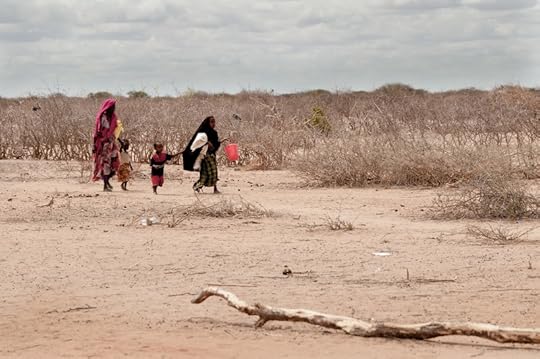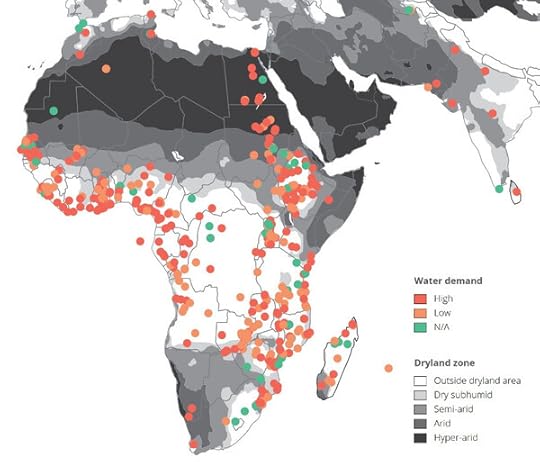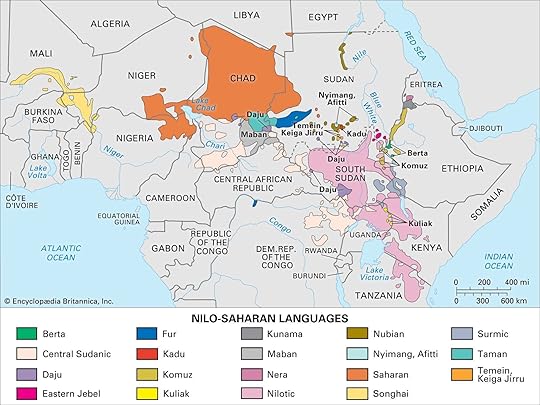Stuart Jeanne Bramhall's Blog: The Most Revolutionary Act , page 160
November 25, 2024
Bone dry: Agribusiness’ African water grab

By Grain
Since the early 2010s corporations have acquired over 7 million hectares of land for large-scale, industrial farms in sub-Saharan Africa, with most of these projects focused on producing water-intensive crops in already water-stressed regions. While the media spotlight is often on climate change-induced droughts, little is being said about the corporate-driven water scarcity these projects are inflicting upon people across Africa. Driven by the goal of expanding export production of water-intensive crops, governments are auctioning Africa’s water resources to the highest bidder. The new rush for land on the continent to grow trees for carbon credits is making this worse.
Water plundering
Only in the last 8 years, companies have signed land deals for over 5 million hectares for water-hungry plants in Africa. Take, for example, the New York-based company African Agriculture Holdings. It planned to use massive amounts of water from the Senegal River– the main water source for Dakar and several other major cities in Senegal, to produce alfalfa for export to South Korea and the Gulf states on 25,000 ha of land within a protected wetland. The company also planned to grow alfalfa on up to 500,000 hectares in neighbouring Mauritania, one of the most water stressed countries on the planet, and to plant a million water-hungry acacia trees in Niger to generate carbon credits. While it now appears that the company is heading for financial ruin, its CEO has already announced a new venture to grow maize on over 600,000 hectares in central Africa.

Development banks, like the African Development Bank (AfDB) and the World Bank, are working with African governments to bankroll a massive rollout of new irrigation projects across the continent to facilitate more of these agribusiness investments. In Tanzania, for instance, the government and the AfDB have budgeted hundreds of millions of dollars of public funds for large-scale irrigation projects with the private sector, with a stated goal of irrigating 8.5 million hectares by 2030– which is more than today’s total irrigated land area in all of sub-Saharan Africa.
In Kenya, President Ruto has pledged nearly US$500 million for irrigation projects nationwide, including the Rwabura irrigation project in Kiambu county, the Iriari project in Embu as well as the Kanyuambora irrigation project. The Kanyuambora, like the others, will draw water from the Thuci river and irrigate 400 hectares, which will be used to farm crops such as horticultural produce.
One company that intends to profit big from this expansion of irrigation in Tanzania, Kenya and other countries in eastern and southern Africa is South Africa-based Westfalia. The company, which is particularly active in avocado production, controls 1,200 hectares in South Africa and 1,400 in Mozambique. With support from South Africa’s government-owned Industrial Development Corporation and the World Bank’s International Finance Corporation, Westfalia is promoting the expansion of the avocado industry in countries such as Mexico, Peru, Chile and Colombia, where avocados have already fuelled a severe water crisis. Replicating this model in other African countries promises to create a similar situation.
Africa’s experience to date with large-scale irrigation projects is dismal. Most of the projects implemented over the past decades failed or are in poor condition. And many of the so-called success cases have caused more harm than good. Consider the irrigation project in Lake Naivasha, Kenya, which triggered a boom in foreign investment in flower farms in the 1980s and 1990s that serve the European and Chinese markets. Only six farms now consume over half of the water volume used for irrigation in the lake’s basin. The impact of the flower farms range from pesticide pollution, to biodiversity loss, and hampering access to safe and clean water for local people. In return there have been few benefits, with workers toiling in gruelling and hazardous conditions for meagre wages and the companies avoiding taxes.
In Morocco fruit exports-primarily destined for European and UK markets-are driven by water hungry crops such as berries, watermelon, citrus and avocados. Between 2016 and 2021 these exports more than doubled. The biggest beneficiaries of this boom are corporations as Les Domaines Export, belonging to the country’s elite, alongside foreign companies like Surexport and Hortifrut, all backed by financial players, including pension funds and development banks. Today, Morocco has more irrigated land area than any other country in Africa, aside from Egypt.
 A pastoralist from Moroto one of the most dry areas in Uganda looking after his herd. Pastoralists in this region move long distances to look for pasture and water for their herds.By Nobert Petro Kalule
A pastoralist from Moroto one of the most dry areas in Uganda looking after his herd. Pastoralists in this region move long distances to look for pasture and water for their herds.By Nobert Petro Kalule
Export oriented industrial agriculture consumes 85% of the country’s water resources, intensifying the severe water stress gripping the kingdom, even as the country endures six consecutive years of drought. To cope with the crisis, the government announced the end of fruit subsidies. Yet, the measure will have little impact on large farms, since they have the financial capacity to continue with their operations, whereas small farmers will be the most affected. Other plans include investing in desalination plants. But the high energy and environmental costs make it far from a sustainable long-term solution.
On the opposite end of the continent, South Africa – one of Africa’s richest economy – has long struggled with a persistent water crisis. This is largely due to the fact that 65 percent of the country’s water resources are allocated to industrial agriculture.
>Africa’s water custodians
The impact of industrial agriculture’s thirst for water is felt most acutely by African women. Already tasked with managing households, caring for families and farming for food, women and young girls are also responsible for collecting all the water needed for both their homes and farms.
As such, they bear the heavy burden of trekking long distances – sometimes multiple times a day – to collect water. It is estimated that African women collectively spend about 40 billion hours annually fetching water. As more of their water sources are diverted for use on export-oriented industrial farms, it will make it even harder for them to access the water they need for their households.
Paradoxically, those most affected by the water issues affecting the continent may also be the ones with the solutions. Rural women possess invaluable knowledge about local water sources, their usage, storage and conservation. They know, for example, ways of recycling water for washing, irrigation and livestock, like the women pastoralists of the Anuak people in Ethiopia’s Gambela region, know how and when to move their animals from wetter areas to drier ones in the rainy season, allowing local rivers to replenish and maintain its fertility.
In Kenya, Martha Waiganjo, a farmer from the dry lands of Gilgil, is one of many smallholder farmers working with the Seed Saver’s Network (SSN) to take advantage of rain water harvesting and conservation techniques as part of their agroecological practices. Through rain water harvesting, farmers like her are able to collect, store and conserve run off rain water for later use.<
The run off water is stored in manually dug up dams that are lined with an anti-seepage layer of plastic commonly known as a dam liner. For Martha, her dam allows her to store close to 40,000 litres of water for her sustenance throughout the year. “[…] Water harvesting has been of great improvement on our farms, we don’t need the rain to plant. We use the water for irrigation and domestic use. The most important thing in water harvesting is that when the area is dry we use the water not only for farming but for the needs of the whole community. It is also of great importance to livestock farming.”
In 2021, the UN estimated that nearly 160 million people in Sub-Saharan Africa (14% of the population) were affected by water scarcity and stress, and, with the effects of climate change now kicking in, the numbers are expected to be even higher in 2025 and beyond.
The fixation of governments, development banks and corporations on large-scale irrigation projects for industrial agriculture in Africa has to end. Water needs to instead be in the hands of the small-scale food producers who feed the continent and who are best able to develop solutions to the challenges posed by climate change.<
[…]
Via https://grain.org/en/article/7208-bone-dry-agribusiness-african-water-grab
Half US at risk for blackouts during extreme cold this winter

By Kevin Killough
“Electricity supplies are at risk from freezing temperatures that threaten reliable operation of BPS [bulk power systems] generators, fuel supply issues for natural-gas-fired generation, and wind and solar resource energy limitations,” the report states.
A new report by the North American Electric Reliability Corporation (NERC), which assesses the United States and Canada’s grid reliability, finds that much of the central and eastern U.S. could experience blackouts should a significant and lasting cold snap descend on the nation.
“Electricity supplies are at risk from freezing temperatures that threaten reliable operation of BPS [bulk power systems] generators, fuel supply issues for natural-gas-fired generation, and wind and solar resource energy limitations,” the report warned.
NERC has been warning for years that increased reliance on unreliable wind and solar threaten grid reliability, but the “2024-2025 Winter Reliability Assessment” explains that as coal resources diminish and the U.S. becomes more reliant on natural gas, pipeline infrastructure may not be adequate to ensure a secure supply to homes and generators.
With the U.S. Energy Information Administration anticipating a colder winter this year, the problem is compounded, according to the report released Thursday.
“Natural-gas-fired power generator availability and output can be threatened when natural gas supplies are insufficient or when the flow of fuel is unable to be maintained,” the report warns.
The areas under the greatest risk of blackouts are those where coal- and natural gas-fired power plants have been taken offline, as well as those who have limited pipeline capacity to ensure secure supplies of natural gas.
The Midcontinent Independent System Operator (MISO), which covers 15 states over the Midwest, northern Great Plains, and south-central U.S., reduced its coal- and natural gas-fired generators by 5 gigawatts since last year. NERC warns that is going to create problems should there be a serious cold snap.
“With fewer internal dispatchable resources and increasing reliance on wind and imports, the risk of supply shortfall in winter has increased in MISO,” the report said.
The average American home consumes approximately 899,000 watt hours per month. Homes consume electricity at different rates during different times of the day, so it’s hard to say, especially with intermittent wind and solar, how many homes could be powered with 5 gigawatts of capacity.
Five gigawatts of electricity generation running for 1 hour could power 50 million 100-watt lightbulbs for one hour.
The Southwest Power Pool, which covers a stretch of the central Great Plains, according to the NERC report, has lost 4 gigawatts of generation capacity from last year. Of that amount, 2 gigawatts is from adjustments in wind and solar capacity, which has a lower energy value during the winter season.
New York and New England both face increased risk of blackouts, according to NERC, due to increased dependency on unreliable wind and solar resources, as well as pipeline issues. PJM, which covers all or parts of a dozen states south of Pennsylvania, including the District of Columbia, is facing litigation over a natural gas pipeline expansion project. If the litigation shuts down the facilities, the PJM area could see problems, the report states.
Natural gas producers, however, disputed some of the report’s conclusions, Utility Dive reports. Dena Wiggins, president and CEO of the Natural Gas Supply Association NGSA), said in a statement that its members “take a multitude of proactive measures to prepare for winter weather so that we can provide safe and reliable service to our customers.”
A NGSA fact sheet details some of the actions the members have taken, including improved communications, increased protection of facilities and equipment, and post-event analysis to track performance and improve weatherization practices.
During its “Winter Market Outlook Virtual Media Event” in October, the American Gas Association discussed the anticipated colder winter in combination with decreasing gas drilling rig counts.
“Despite these numbers going down, we are still seeing healthy production coming out of the drilling rigs,” Liz Pardue, director of economic and regulatory analysis for the AGA, said.
Lauren Scott, market and regulatory analysis for AGA, said that natural gas pipeline operators utilize a number of financial and physical mechanisms to “ensure that they’re able to heat your home, not just throughout the entire winter heating season, but on the coldest day of the year.”
The NERC report recommends that utilities complete winter readiness plans prior to December, be aware of the potential for short-term demand forecasts to underestimate demand in extreme cold events, and to implement fuel surveys to ensure adequate supplies of natural gas.
[…]
IMF Calls For Economy-Crushing Carbon Restrictions That Dwarf COVID Lockdowns

Zero Hedge
At the height of the covid lockdowns and mandates a massive portion of the global economy was shut down, leading to supply chain instability, huge job losses and a stagflationary crisis. However, climate change propagandists argued that the event was actually a positive for the planet when it was revealed that emissions fell by 5.4%. They asserted that the covid lockdowns were a practice run for what they called “climate lockdowns” – Presenting a plan for scheduled disruptions to global economic activity as a means to slow the effects of climate change.
Globalists also presented climate lockdowns as a kind of collective social punishment in the event that populations refused to cut carbon output on their own. As World Economic Forum “Agenda Contributor” Mariana Mazzucato argued in 2020:
“Under a “climate lockdown,” governments would limit private-vehicle use, ban consumption of red meat, and impose extreme energy-saving measures, while fossil-fuel companies would have to stop drilling. To avoid such a scenario, we must overhaul our economic structures and do capitalism differently.
Many think of the climate crisis as distinct from the health and economic crises caused by the pandemic. But the three crises – and their solutions – are interconnected…”
After a public uproar over the notion of extending pandemic lockdowns into climate lockdowns, the establishment media would go on to “Fact Check” the issue and assert that it was a “conspiracy theory.” They lied.
The pandemic lockdowns would eventually be exposed as pointless; a disastrous drain on the global economy that did nothing to prevent the spread of the covid virus. But as we witnessed with most of the restrictions instituted during covid, the goal was never to protect the health of the populace. Rather, the goal was to acclimate the populace to an exponentially increasing list of violations of their basic freedoms.
One organization that has a distinct interest in diminishing economic activity for the sake of preventing global warming is the International Monetary Fund (IMF). In a recent ‘call for global climate action’ the IMF states that restrictions on economic activity and general emissions activity would have to far surpass those enforced during the pandemic in order to get to their stated temperature target of less than 1.5°C.
Open lockdowns of developed nations might not ultimately be the tool that globalists use to reach net zero, but carbon taxation on an oppressive scale could end up having the same effect. Carbon taxes could act like steep interest rate increases commonly used by central banks to slow economic activity during inflation. An indirect economic shut down of this magnitude would be absolutely devastating for western nations in particular, resulting in crippling energy shortages, food shortages, job losses, and eventually total collapse and a population plunge.
Net zero is not possible otherwise.
The IMF and other globalist organizations suggest that all nations must achieve a net zero carbon goal by 2030 in order to avoid the “climate cliff” – The theory that once the Earth hits warming of more than 1.5°C, there will be a domino effect which will lead to environmental catastrophe and even more carbon emissions and warming.
To be clear, there is no evidence whatsoever to support the idea of the climate cliff, primarily because there is no evidence of a causation relationship between carbon emissions and global warming. In fact, there is no evidence that that human industry has a warming effect on the climate whatsoever.
Temperature records for hundreds of millions of years prove that warming periods are a mainstay of the Earth’s climate history. In comparison, our current era is one of the coldest, not the warmest. Climate scientists ignore this data and use temperature records going back to the 1880s. Meaning, their data is based on a mere 140 years of the Earth’s history.
The current warming rate is not significant to other periods, nor is there any evidence that human activity is causing it. Data on carbon levels of the past show that temperatures do not necessarily rise in tandem with carbon activity. Carbon emissions are also far lower today than they have been in the past. The claim that carbon concentration due to human activity has a drastic influence on global temperatures (or weather) is absolutely unfounded.
The real reason for climate controls and carbon taxes seems to have far more to do with wealth redistribution from developed nations over to developing nations. The agenda is about centralizing the control of national wealth as well as individual liberties and private property. And the IMF, of course, would like to be one of the institutions at the helm of that wealth management empire.
[…]
Via https://www.zerohedge.com/economics/imf-calls-carbon-restrictions-economy-bigger-covid-lockdowns
Fleet of drones spotted over major US airbase in Britain

By
The largest American airbase on British soil was buzzed by drones this week, the US Air Force has confirmed, amid unconfirmed reports that fighter planes were dispatched to intercept the encroaching aircraft.
The incident occurred on Wednesday above RAF Lakenheath in Suffolk, which has been earmarked as a storage facility for US nuclear warheads three times more powerful than the Hiroshima bomb.
While US Air Forces in Europe (USAFE) played down the incursion, it will do little to dampen the prevailing mood of unease following warnings from Vladimir Putin that Ukraine’s use of British and American long-range weaponry could see military facilities in those countries targeted.
[…]
USAFE declined to comment on either claims that flight operations were affected or the reported deployment of F-15E Strike Eagles.
‘To protect operational security, we do not discuss our specific force protection measures, but retain the right to protect the installation,’ the spokesperson added.
RAF Lakenheath, which appears poised to house US nuclear weapons for the first time in 15 years, is home to the 48th Fighter Wing and a site of major strategic significance as the US moves to bolster its European presence in the face of Russian expansionism.
Earlier this year, unredacted documents from the US Department of Defence’s procurement database showed that the Pentagon has ordered equipment, including ballistic shields, for the airbase.
The construction of facilities to house US soldiers at Lakenheath, where the drone incursion follows similar activity above the US Army’s Picatinny Arsenal in northern New Jersey two days earlier.
The American army has revealed that it is developing special ammunition to shoot down spy drones, with helicopters and tanks to be equipped with medium-calibre rounds capable of hitting small, high-speed targets.
‘There’s not enough air defence assets out there,’ Major General John T Reim, the Picatinny Arsenal’s commanding general, told military website Task and Purpose last month.
[…]
The developments follow warnings from Russian officials that British support for Ukraine, which this week fired UK-supplied Storm shadow missiles into Russian territory for the first time, could ‘lead to a collision between nuclear powers’
[…]
Florida Surgeon General Advises Communities to Cease Water Fluoridation

By Carla Bayron and FOX 13 News Staff
Florida Surgeon General opposes fluoride in drinking water
FOX 13’s Carla Bayron reports on Florida Surgeon General Dr. Joseph Ladapo announcing new guidelines that advise all cities and counties statewide to stop adding fluoride to drinking water.
Surgeon General Dr. Joseph Ladapo announced new guidelines on Friday, advising that all cities and counties statewide stop adding fluoride to drinking water.
Dr. Ladapo spoke at a news conference in Winter Haven, which made headlines last week after the city announced that fluoride will no longer be added to its water supply by the end of the year.
Dr. Ladapo news conference on fluoride in water
Florida Surgeon General Dr. Joseph Ladapo spoke in Winter Haven on Friday, saying all communities statewide should stop adding fluoride to drinking water.
“It is public health malpractice with the information that we have now to continue adding fluoride to water,” Dr. Ladapo said, mentioning studies that point out the possibility of excessive fluoride exposure causing lower IQ levels and mental health issues among children.
The debate over whether fluoride poses a health hazard when ingested goes beyond the brain, with critics arguing it could also cause dental and bone diseases. Supporters of fluoridation, though, consider it one of the greatest public health achievements of the last century.
Dr. Ladapo’s stance on the issue is in line with that of Robert F. Kennedy, Jr., President-elect Donald Trump’s nominee for secretary of the Department of Health and Human Services. Kennedy has said he would recommend removing fluoride from drinking water nationwide.
The U.S. Environmental Protection Agency (EPA) is now studying the issue more, as well, although it could take up to three years to find out the results.
“In September, a recent federal judge in San Franciso made a ruling against the EPA that stated that fluoride in drinking water at the current recommended level of 0.7 milligrams per liter poses a unreasonable risk of hazard to child IQ because there’s not enough of a margin of safety between the hazard level and the exposure level added to community drinking water,” said Dr. Ashley Malan, an assistant professor with the Department of Epidemiology at the University of Florida.
The history of fluoride in drinking water dates back generations, with researchers saying it is the primary source of fluoride for Americans and is a tool to help reduce tooth decay.
Officials lowered their recommendation for drinking water fluoride levels in 2015 to address a tooth condition called fluorosis, that can cause splotches on teeth and was becoming more common in U.S. kids.
There are other sources of fluoride in toothpaste and mouthwash. It also occurs naturally in many foods, like potatoes, spinach, grapes and most seafood. Black tea and white wine also contain fluoride.
The Centers for Disease Control and Prevention says parents should not use fluoride toothpaste for children under 2 unless recommended by a dentist, use only a pea-sized amount of toothpaste for children 2 through 6, and avoid fluoride mouthwash.
[…]
Via https://www.fox13news.com/news/florida-surgeon-general-announcing-new-guidance-water-treatment
November 24, 2024
The Great Cholesterol Scam and the Dangers of Statins

A Midwestern Doctor
Story at-a-glanceThe primary approach to treating heart disease is to prescribe costly cholesterol-lowering statins (to the point over a trillion dollars have now been spent on them). Unfortunately, these highly toxic drugs have minuscule benefits (e.g., at best taking them for years extends your life by a few days)Statins are also one of the most frequent causes of pharmaceutical injuries (e.g., they are notorious for causing muscle, nerve, or liver damage and significant cognitive impairment). This is because statins work by blocking the body’s production of various essential nutrientsMany of these failures can be explained by the fact there is very little evidence cholesterol actually causes heart disease. Rather, heart disease results from (cholesterol containing) atherosclerotic blood clots accumulating at the sites of past injuries to the blood vesselsIn this article, we will review the dangers of statins, the actual causes of heart disease, and how this knowledge can be integrated to develop a healthy approach to cardiovascular healthMedicine depends upon recurring sales to large markets. In turn, as comedian Jimmy Dore shows, the War against Cholesterol and the relentless promotion of statins is one of the most harmful things the medical industry has done to America:
The Statin Damage CrisisLess severe reactions to a toxin are much more common than severe ones. Because of this, if you see a cluster of severe reactions, it indicates that far more, less severe reactions are occurring as well (which is how after learning a few people in my social circle had died suddenly from the COVID vaccines, I was able to correctly predict the almost unfathomable scale of the nonfatal COVID vaccine injuries that would hit America).
[image error]Likewise, if you see a large number of less severe reactions to a pharmaceutical, you can predict far more severe injuries are lurking in the background. In turn, available data shows statins injure roughly 1 in 5 recipients, most frequently with:
Muscle damage (e.g., muscle pain and inflammation)1,2,3,4,5,6,7,8,9,10,11,12,13Fatigue14,15 (especially with exertion and exercise)16Diabetes17,18,19,20,21 (particularly in women)22,23,24Liver dysfunction and failure25,26Likewise, even more severe injuries can also occur far too frequently such as:
Psychiatric and neurologic issues such as depression, confusion, aggression, and memory loss27,28,29,30,31,32,33,34,35,36ALS-like conditions and other central motor disorders (e.g., Parkinson’s disease and cerebellar ataxia)37,38,39,40,41Note: A more detailed list of statin side effects can be found here.
Sadly, effective marketing has made the medical profession remarkably resistant to acknowledging these frequent side effects of statins.
Statin Neurotoxicity“Many statin victims say that abruptly, almost in the blink of an eye, they have become old people.” — Duane Graveline MD42
Dr. Graveline awoke to this issue after being started on a statin and then developing global amnesia (which is really scary) which disappeared once he stopped the statin.43
“When I suggested, on the basis of my 23 years as a family doctor, that perhaps my new medicine was the cause of my amnesia, the neurologist replied, almost scoffingly, that ‘Statins do not do that.’ He and many other physicians and pharmacists were adamant that this does not occur.”
Eventually, he was persuaded to try again.
“The year passed uneventfully and soon it was time for my next astronaut physical. NASA doctors joined the chorus I had come to expect from physicians and pharmacists during the preceding year, that statin drugs did not do this and at their bidding I reluctantly restarted Lipitor at one-half the previous dose.
Six weeks later I again descended into the black pit of amnesia, this time for twelve hours and with a retrograde loss of memory back to my high school days.”
Later he discovered:
“Perhaps stockholder loyalty explains why Pfizer management knew over a decade ago, during the first human use trial of Lipitor, of the cognitive impact to come when Lipitor was released to the public. Of their 2,503 patients tested with Lipitor, seven experienced transient global amnesia attacks and four others experienced other forms of severe memory disturbances, for a total of 11 cases out of 2,503 test patients.
This is a ratio of 4.4 cases of severe cognitive loss to result from every 1000 patients that took the drug. Not one word of warning of this was transmitted to the thousands of physicians who soon would be dispensing the drug.”
Because of this and other debilitating long-term complications (e.g., previously an extremely fit individual, he developed chronic exhaustion), Graveline became an expert on statin injuries and, in 2014, wrote “The Statin Damage Crisis,”44 a book which explains why these drugs are so dangerous.
Why Statins Are HarmfulStatins work by inhibiting an easy to target enzyme that is necessary for the production of cholesterol. Unfortunately, blocking that enzyme disrupts a variety of other vital physiologic processes. Let’s review what that enzyme does:
[image error]Since each of these enzymes is essential for the body, many problems can ensue.
Note: Some of the other affected biomolecules include nuclear factor-kappa B, tau proteins, and selenoproteins.
CholesterolCholesterol has a few different essential functions in the body. These include:
• It is the precursor to many different hormones.
• The brain’s synapses (which, amongst other things, form memories) require cholesterol to function. Since cholesterol is too big to enter the brain, glial cells (support cells of the nervous system) synthesize it within the brain. Statins, unfortunately, inhibit glial cell production of cholesterol.
• Cognition is highly dependent upon cholesterol. For example, one study45 found that minor cognitive impairment could be detected in 100% of statin users if sufficiently sensitive testing was done (again illustrating how minor injuries are more common than severe ones). Likewise, a variety of more severe adverse effects on cognition are also observed:
“A patient’s rapid descent into dementia after a statin is started is much too often written off by their doctor as senile brain changes or beginning Alzheimer’s when the real culprit is their statin.”
[…]
Numerous studies have also found a significant association46 between low or lowered cholesterol levels and violence. Likewise, statin dementia is often characterized by aggression.
Finally, one of the most concerning side effects of statins is their tendency to cause ALS (a truly horrible rare disease — curiously also seen in association with the COVID-19 vaccines). This correlation is further supported by many reports of statin ALS improving once the statin is stopped.47
CoQ10CoQ10 is an essential nutrient that both the mitochondria (which power the human body) and the stability of our cell walls depend upon. CoQ10 deficiency caused by statins is generally considered the most common cause of their side effects. This is really sad because those side effects could have been prevented if CoQ10 had been given with the statin. Unfortunately, this is unlikely ever to happen, as doing so would be equivalent to an admission statins could cause harm.
[…]
Some of the common energy-related side effects of statin CoQ10 deficiency include:
Mitochondrial damageLack of energyChronic fatigue syndromeCongestive heart failure and fluid retentionShortness of breathGoutSome of the side effects of statin CoQ10 deficiency weakening cell wall integrity include:
PancreatitisRhabdomyolysis (rapid breakdown of skeletal muscle tissue)Tendon and ligament inflammation and ruptureHepatitis[…]
Two of the most common consequences of statins CoQ10 depletion are myopathy (muscle pain, tiredness, weakness, and cramps) and peripheral neuropathy (numbness, tingling, or burning sensations, particularly in hands and feet).
Although myopathy is the most commonly reported side effect of statin usage, much of it (e.g., myositis) goes undetected. This is because the symptoms are often not accompanied by blood work showing muscle enzyme elevations and can only be detected by biopsies (which are rarely done relative to blood work).
One of the sadder things about statins is how aggressively they are pushed on diabetics (under the logic that since diabetics have an increased risk of heart disease, it is critical they take a statin to prevent them from having a heart attack). To highlight the absurdity of this, statins are well known to significantly increase your risk of diabetes (multiple studies have found this49), which I suspect is again due to them impairing mitochondrial function.
Similarly, peripheral neuropathy is a condition diabetics are well known to be at a high risk of. In one study, it was found that the risk of neuropathy (e.g., burning pain with tingling or numbness of the extremities) was increased by 14 to 26 times (depending on the type) for long-term users of statins.50 Likewise, other nerve issues, such as neurodegeneration, can be caused by statins.
[…]
The small cardiovascular benefit from statins may come not from lowering cholesterol but from their anti-inflammatory properties, as they inhibit NF-kB, a key immune system component involved in inflammation (which causes heart disease). Statins also lower C-reactive protein, another inflammatory marker. However, by suppressing the immune system, they may reduce protection against infections and increase cancer risk.51
For example, a Japanese study found that 13.3% of lymphoid cancer patients had been on statins, compared to only 7.3% of non-cancer patients.52 In the PROSPER trial (a major statin study), while statins slightly reduced heart attack deaths, they were linked to a significant rise in cancer deaths, effectively neutralizing the cardiovascular benefit. Including nonfatal cancers, the difference between the control and statin groups grew each year.53
In addition to this, arguing that some of the benefit of statins “preventing heart attacks” is due to them causing a fatal cancer before you have time to have a natural heart attack, this situation is somewhat analogous to what was seen with the COVID vaccines (which also cause cancer).54
There, the “benefit” of the COVID vaccines preventing COVID was outweighed by them causing serious conditions such as heart attacks and strokes, but if one only focused on them preventing COVID (which many did), the vaccines could be portrayed as life-saving, even though they overall did the opposite.
[…]
To sell a blockbuster drug, it’s often necessary to cement a cultural mythology behind it. For example, the antidepressant industry spent years convincing the public depression was due to a “chemical imbalance” (when in reality — raising serotonin causes suicidality), and as a result, despite the chemical imbalance theory having been disproven, over 13%55 of Americans take these dangerous, unnecessary and highly addictive drugs (a figure that sadly continues to rapidly rise).56
One of the cleverest campaigns I’ve seen within the medical industry is the widespread belief that heart disease is due to fat clogging the arteries much like they do for a drain pipe.
This marketing slogan in turn is remarkably persuasive as it is easy to understand (e.g., people without a medical background will feel confident repeating it to others), easy to visualize, and highly likely to elicit an immediate sense of disgust. But is it actually true?
The Clot ThickensMalcolm Kendrick57 has extensively explored cholesterol, including a major mystery in cardiology — the fact that there is no common thread between the well-known risk factors for heart disease. For example, to calculate the risk of heart disease, England uses a calculator58 that combines the adjustable risks for heart disease (e.g., age) with the conditions most strongly associated with causing heart disease.
AgeSexEthnicitySmokingDiabetesHigh BMIPostcodeAngina, or heart attack in first degree relative under the age of 60Atrial fibrillationRaised blood pressureHistory of migrainesChronic kidney diseaseRheumatoid arthritisSevere mental illnessSystemic lupus erythematosus (SLE)Variation in two blood pressure readingsOn atypical antipsychotic medicationUsing steroid tabletsTotal cholesterol/HDL ratioDiagnosis of erectile dysfunctionLikewise, in a 2017 study, the records of 378,256 English patients were analyzed by an AI system to determine what characteristics put them at the highest risk for a cardiovascular incident in the next 10 years. From that, they found that the ten greatest risk factors59 (in order) were:
Chronic obstructive pulmonary diseaseOral corticosteroid prescribedAgeSevere mental illnessEthnicity South AsianImmunosuppressant prescribedSocio-economic status quintile 3Socio-economic status quintile 4Chronic kidney diseaseSocio-economic status quintile 2[…]
Via https://articles.mercola.com/sites/articles/archive/2024/11/15/statins-cholesterol.aspx
Trump Reportedly Opposes Israel’s Annexation of West Bank
![Former US President Donald Trump makes a speech as he attends the 2024 Conservative Political Action Conference (CPAC) at the Gaylord National Resort and Convention Center in National Harbor, Maryland, United States on February 24, 2024 [Celal Güneş/Anadolu Agency]](https://i.gr-assets.com/images/S/compressed.photo.goodreads.com/hostedimages/1732588550i/36223401._SX540_.jpg)
Former US President Donald Trump makes a speech as he attends the 2024 Conservative Political Action Conference (CPAC) at the Gaylord National Resort and Convention Center in National Harbor, Maryland, United States on February 24, 2024 [Celal Güneş/Anadolu Agency
Middle East MonitorNewly-elected United States’ President, Donald Trump, is in opposition to Israel’s reported plans to annex the Occupied West Bank, sources from his Republican Party have revealed.
According to Israeli outlet, Ynet News, a senior Republican Senator close to the President-elect has said that “Trump will not approve annexation” of the West Bank.
Such a move is reportedly seen by the new President as one that would be “a mistake for Israel” which would worsen its international standing – already severely damaged after over a year of the Occupation’s bombardment and invasion of the Gaza Strip.
Trump is also apparently primarily concerned that any official annexation could further disrupt and severely derail efforts to finally reach a normalisation between Israel and Saudi Arabia – a key priority for the incoming Trump administration, with Republican Senator, Lindsey Graham, particularly working on that goal.
The reported comments by the unnamed sources follow increased speculation in recent weeks over Trump’s appointments of controversial figures in his incoming administration, with many of the relevant roles being filled by radically pro-Israel figures who favour annexation of the West Bank
[…]
Pentagon running out of missiles – after Dec 1, that will be big problem.
Protracted wars in the Middle East and Ukraine are draining the US arsenal of interceptor missiles. The problem is especially severe in Palestine and in the Red Sea, where dozens of missiles are launched monthly against incoming rockets and drones. Pentagon officials are urgently pushing weapons makers to produce more, but are bumping up against capacity and CAPEX constraints. In another blow, China just announced an export ban on dual-use metals that are critical to the manufacture of missiles and other aerospace applications in the defense sector. Magnesium and tungsten, in particular, are two key materials necessary for the production of missiles, but where China effectively has monopolized the refining and production. China’s export ban will take effect on 1 December.
Resources and links:
Wall Street Journal, Pentagon Runs Low on Air-Defense Missiles as Demand Surges https://www.wsj.com/politics/national…
Nikkei Asia, China to tighten export curbs on critical metals ahead of Trump’s return https://asia.nikkei.com/Spotlight/Sup…
Six Strategic Metals Widely Used in the Military Industry https://www.samaterials.com/content/s…
Magnesium in Defence https://www.magnium.com.au/defence-metal
Forbes, The Titanium Supply Chain For The Aerospace Industry Goes Through Russia https://www.forbes.com/sites/willyshi…
[…]
UK signals it would arrest Netanyahu
 FILE PHOTO: Israel’s PM Benjamin Netanyahu leaves Downing Street 10 on March 24, 2023 in London © Carl Court / Getty Images
FILE PHOTO: Israel’s PM Benjamin Netanyahu leaves Downing Street 10 on March 24, 2023 in London © Carl Court / Getty ImagesRT
Britain would most likely honor the International Criminal Court’s arrest warrant against Israeli Prime Minister Benjamin Netanyahu if he came to visit, a spokesman for 10 Downing Street has said.
The Hague-based ICC announced on Thursday it was seeking Netanyahu on charges of war crimes and crimes against humanity in connection with the Gaza conflict. Israel and the US have denounced the move.
“The UK will always comply with its legal obligations as set out by domestic law, and indeed international law,” a spokesman for Prime Minister Keir Starmer told British media on Friday.
However, he added that domestic procedures linked to ICC arrest warrants have never been used by the UK, because no one wanted by the court has ever visited the country.
Earlier in the day, Home Secretary Yvette Cooper said it “wouldn’t be appropriate” for her to comment on the warrant, as the ICC is an independent institution.“We’ve always respected the importance of international law, but in the majority of the cases that they pursue, they don’t become part of the British legal process,” she told Sky News. “What I can say is that obviously, the UK government’s position remains that we believe the focus should be on getting a ceasefire in Gaza.”
Emily Thornberry, the Labour MP who chairs the Foreign Affairs Committee, was more direct when she spoke to the outlet, however.
“If Netanyahu comes to Britain, our obligation under the Rome Convention would be to arrest him under the warrant from the ICC,” said Thornberry. “Not really a question of should, we are required to because we are members of the ICC.”
Israel “rejects with disgust the absurd and false actions leveled against it by ICC,” Netanyahu’s office has said. The US “fundamentally rejects” the decision and is “deeply concerned” by the “troubling process errors” that led to it, a spokesperson for the National Security Council said on Thursday.So far, the Netherlands, Switzerland, Ireland, Italy, Sweden, Belgium, and Norway have announced they would comply with the ICC warrant, while France has said the warrant is legitimate but actually arresting the Israeli leader would be “legally complex.”
[…]
Via https://www.rt.com/news/608076-uk-netanyahu-icc-arrest-warrant/
Nilo-Saharan: Africa’s Hardest Languages

Episode 10 Nilo-Sarahan Africa’s Hardest Languages
Language Families of the World
Dr John McWhorter
Film Review
While Afro-Asiatic languages are spoken mainly in northern and Niger-Congo languages in southern Africa, the Nilo-Saharan languages are spoken in central Africa. This family consists of roughly 100 languages that arose when the Sahara Desert was still grassy savanna.
The two best known Nilo-Saharan languages are Fur (spoken in Darfur) and Masai, spoken by Masai tribesmen (found in Kenya and northern Tanzania).
The four written Nilo-Saharan languages are Luo, Kalenjn, Dinka and Nuer.
With so few common words in different Nilo-Saharan languages, it’s extremely difficult to construct a proto-Nilo-Saharan language. However all but two languages in this family use similar words for “will” and “cow.”
In general, African languages are most likely to have similar words for cattle, given that pastoralism arose in Africa around 9,000 before most languages split off from their proto language root. There are somewhat fewer similar words for concepts developing more recently, eg agriculture and cultivated foods, which emerged around 7,000 BC. Most words for domesticated sheep and goats, which appeared around 6,000 BC, are borrowed from Afro-Asiatic languages.
One similarity found among most Nilo-Sahaan languages is that the pronoun “I” nearly always contains an “a” sound, the pronoun you an “i” sound and the pronouns he/she/it an “e” sound. Also most Nilo-Saharan languages lack a “d” sound, which may relate to the common practice of mutilating the lips with jewelry.

The Dinka language uses tones (like Chinese) to convey specific meanings. Fur has lots of of irregular plurals.
It’s believed the three click language families (see The History of African Click Languages ) were the first to emerge in Africa.
The five major African families are Osmotic, Khoison, Niger-Congo, Afro-Asiatic, Nilo-Sarahan. The two minor African families are Mande and Ijoid (spoken in Congo).
Malagasy, the language spoken on the island of Madagascar is an Austronesian language.
Film can be viewed free with a library card on Kanopy.
https://www.kanopy.com/en/pukeariki/watch/video/6120000/6120020
The Most Revolutionary Act
- Stuart Jeanne Bramhall's profile
- 11 followers





